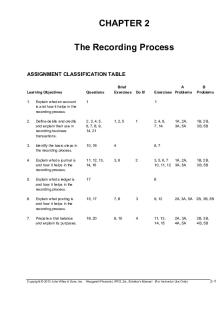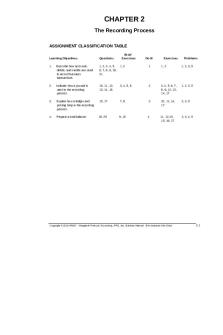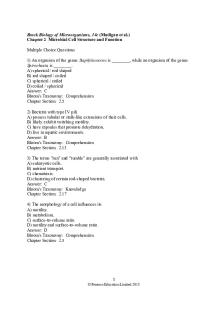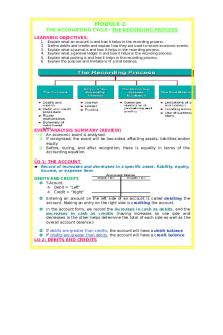Ch02 - The Recording Process solution PDF

| Title | Ch02 - The Recording Process solution |
|---|---|
| Author | Md. Sharif Hassan |
| Course | Principles of Accounting |
| Institution | University of Dhaka |
| Pages | 56 |
| File Size | 733 KB |
| File Type | |
| Total Downloads | 89 |
| Total Views | 159 |
Summary
The Recording Process solution...
Description
CHAPTER 2 The Recording Process ASSIGNMENT CLASSIFICATION TABLE Brief Exercises
A Problems
B Problems
1A, 2A, 3A, 5A
1B, 2B, 3B, 5B
1A, 2A, 3A, 5A
1B, 2B, 3B, 5B
9, 12
2A, 3A, 5A
2B, 3B, 5B
9, 10, 11, 13, 14
2A, 3A, 4A, 5A
2B, 3B, 4B, 5B
Study Objectives
Questions
Exercises
1.
Explain what an account is and how it helps in the recording process.
1
2.
Define debits and credits and explain their use in recording business transactions.
2, 3, 4, 5, 6, 7, 8, 9, 14
1, 2, 5
2, 4, 6, 7, 14
3.
Identify the basic steps in the recording process.
10, 19
4
6, 7
4.
Explain what a journal is and how it helps in the recording process.
11, 12, 13, 14, 16
3, 6
3, 5, 6, 7 10, 11, 12
5.
Explain what a ledger is and how it helps in the recording process.
17
6.
Explain what posting is and how it helps in the recording process.
15, 17
7, 8
7.
Prepare a trial balance and explain its purposes.
18, 20
9, 10
1
8
2-1
ASSIGNMENT CHARACTERISTICS TABLE Problem Number
Difficulty Level
Description
Time Allotted (min.)
1A
Journalize a series of transactions.
Simple
20–30
2A
Journalize transactions, post, and prepare a trial balance.
Simple
30–40
3A
Journalize and post transactions, and prepare a trial balance.
Moderate
40–50
4A
Prepare a correct trial balance.
Moderate
30–40
5A
Journalize transactions, post, and prepare a trial balance.
Moderate
40–50
1B
Journalize a series of transactions.
Simple
20–30
2B
Journalize transactions, post, and prepare a trial balance.
Simple
30–40
3B
Journalize transactions, post, and prepare a trial balance.
Moderate
40–50
4B
Prepare a correct trial balance.
Moderate
30–40
5B
Journalize transactions, post, and prepare a trial balance.
Moderate
40–50
2-2
Study Objective
Knowledge
Comprehension
Application
Analysis
Evaluation
Q2-1 E2-1
Explain what an account is and how it helps in the recording process.
2.
Define debits and credits and explain their use in recording business transactions.
3.
Identify the basic steps in the recording process.
Q2-10
Q2-19 BE2-4
E2-6 E2-7
4.
Explain what a journal is and how it helps in the recording process.
Q2-12
Q2-11 Q2-13 Q2-14
Q2-16 BE2-3 BE2-6 E2-3 E2-5 E2-6
E2-7 E2-10 E2-11 E2-12 P2-1A P2-2A
5.
Explain what a ledger is and how it helps in the recording process.
E2-8
Q2-17
6.
Explain what posting is and how it helps in the recording process.
Q2-15 Q2-17
BE2-7 BE2-8 E2-9 E2-12
P2-2A P2-3B P2-3A P2-5B P2-5A P2-2B
7.
Prepare a trial balance and explain its purposes.
Q2-18
BE2-9 E2-9 E2-10 E2-11
E2-14 P2-2B Q2-20 P2-2A P2-3B BE2-10 P2-3A P2-5B E2-13 P2-5A P2-4A
2-3
1.
Broadening Your Perspective
Synthesis
Q2-2 Q2-3 Q2-4 Q2-5 Q2-6 Q2-7 Q2-8
Q2-9 Q2-14 BE2-1 BE2-2 BE2-5 E2-2 E2-4
E2-6 E2-7 E2-14 P2-1A
P2-2A P2-2B P2-3A P2-3B P2-5A P2-5B P2-1B
P2-3A P2-5A P2-1B P2-2B P2-3B P2-5B
Financial Reporting Decision Making Across the Organization Exploring the Web
P2-4B
Comparative Analysis Communication All About You Decision Making Ethics Case Across the Organization
BLOOM’S TAXONOMY TABLE
Correlation Chart between Bloom’s Taxonomy, Study Objectives and End-of-Chapter Exercises and Problems
ANSWERS TO QUESTIONS 1.
A T account has the following parts: (a) the title, (b) the left or debit side, and (c) the right or credit side.
2.
Disagree. The terms debit and credit mean left and right respectively.
3.
Jeff is incorrect. The double-entry system merely records the dual effect of a transaction on the accounting equation. A transaction is not recorded twice; it is recorded once, with a dual effect.
4.
Maria is incorrect. A debit balance only means that debit amounts exceed credit amounts in an account. Conversely, a credit balance only means that credit amounts are greater than debit amounts in an account. Thus, a debit or credit balance is neither favorable nor unfavorable.
5.
(a) Asset accounts are increased by debits and decreased by credits. (b) Liability accounts are decreased by debits and increased by credits. (c) Revenues and owner’s capital are increased by credits and decreased by debits. Expenses and owner’s drawing are increased by debits and decreased by credits.
6.
(a) (b) (c) (d) (e) (f) (g)
Accounts Receivable—debit balance. Cash—debit balance. Owner’s Drawing—debit balance. Accounts Payable—credit balance. Service Revenue—credit balance. Salaries Expense—debit balance. Owner’s Capital—credit balance.
7.
(a) (b) (c) (d) (e)
Accounts Receivable—asset—debit balance. Accounts Payable—liability—credit balance Equipment—asset—debit balance. Owner’s Drawing—owner’s equity—debit balance. Supplies—asset—debit balance.
8.
(a) Debit Supplies and credit Accounts Payable. (b) Debit Cash and credit Notes Payable. (c) Debit Salaries Expense and credit Cash.
9.
(1) (2) (3) (4) (5) (6)
10.
Cash—both debit and credit entries. Accounts Receivable—both debit and credit entries. Owner’s Drawing—debit entries only. Accounts Payable—both debit and credit entries. Salaries Expense—debit entries only. Service Revenue—credit entries only.
The basic steps in the recording process are: (1) Analyze each transaction for its effect on the accounts. (2) Enter the transaction information in a journal. (3) Transfer the journal information to the appropriate accounts in the ledger.
2-4
Questions Chapter 2 (Continued)
11.
The advantages of using the journal in the recording process are: (1) It discloses in one place the complete effects of a transaction. (2) It provides a chronological record of all transactions. (3) It helps to prevent or locate errors because the debit and credit amounts for each entry can be easily compared.
12.
(a) The debit should be entered first. (b) The credit should be indented.
13.
When three or more accounts are required in one journal entry, the entry is referred to as a compound entry. An example of a compound entry is the purchase of equipment, part of which is paid for with cash and the remainder is on account.
14.
(a) No, debits and credits should not be recorded directly in the ledger. (b) The advantages of using the journal are: 1. It discloses in one place the complete effects of a transaction. 2. It provides a chronological record of all transactions. 3. It helps to prevent or locate errors because the debit and credit amounts for each entry can be easily compared.
15.
The advantage of the last step in the posting process is to indicate that the item has been posted.
16.
(a) Cash............................................................................................................. Hector Molina, Capital .................................................................... (Invested cash in the business)
9,000
(b) Prepaid Insurance ..................................................................................... Cash .................................................................................................. (Paid one-year insurance policy)
800
(c)
17.
9,000
800
Supplies....................................................................................................... Accounts Payable ........................................................................... (Purchased supplies on account)
2,000
(d) Cash ............................................................................................................. Service Revenue ............................................................................. (Received cash for services rendered)
7,500
2,000
7,500
(a) The entire group of accounts maintained by a company, including all the asset, liability, and owner’s equity accounts, is referred to collectively as the ledger. (b) A chart of accounts is a list of accounts and the account numbers that identify their location in the ledger. The chart of accounts is important, particularly for a company that has a large number of accounts, because it helps organize the accounts and identify their location in the ledger. The numbering system used to identify the accounts usually starts with the balance sheet accounts and follows with the income statement accounts.
2-5
Questions Chapter 2 (Continued)
18.
A trial balance is a list of accounts and their balances at a given time. The primary purpose of a trial balance is to prove (check) that the debits equal the credits after posting. A trial balance also facilitates the discovery of errors in journalizing and posting. In addition, it is useful in preparing financial statements.
19.
No, Jim is not correct. The proper sequence is as follows: (b) Business transaction occurs. (c) Information entered in the journal. (a) Debits and credits posted to the ledger. (e) Trial balance is prepared. (d) Financial statements are prepared.
20.
(a) The trial balance would balance. (b) The trial balance would not balance.
2-6
SOLUTIONS TO BRIEF EXERCISES BRIEF EXERCISE 2-1
1. 2. 3. 4. 5. 6.
Accounts Payable Advertising Expense Service Revenue Accounts Receivable A. J. Ritter, Capital A. J. Ritter, Drawing
(a) Debit Effect Decrease Increase Decrease Increase Decrease Increase
(b) Credit Effect Increase Decrease Increase Decrease Increase Decrease
(c) Normal Balance Credit Debit Credit Debit Credit Debit
BRIEF EXERCISE 2-2
June 1 2 3 12
Account Debited Cash Equipment Rent Expense Accounts Receivable
Account Credited Hank Norris, Capital Accounts Payable Cash Service Revenue
BRIEF EXERCISE 2-3 June 1 2 3 12
Cash.................................................................................. Hank Norris, Capital ...........................................
5,000
Equipment ...................................................................... Accounts Payable ...............................................
900
Rent Expense ................................................................ Cash.........................................................................
800
Accounts Receivable .................................................. Service Revenue..................................................
300
2-7
5,000 900 800 300
BRIEF EXERCISE 2-4 The basic steps in the recording process are: 1.
Analyze each transaction. In this step, business documents are examined to determine the effects of the transaction on the accounts.
2.
Enter each transaction in a journal. This step is called journalizing and it results in making a chronological record of the transactions.
3.
Transfer journal information to ledger accounts. This step is called posting. Posting makes it possible to accumulate the effects of journalized transactions on individual accounts.
BRIEF EXERCISE 2-5 (a)
Effect on Accounting Equation
(b)
Debit-Credit Analysis
The asset Cash is increased; the owner’s equity account T. J. Carlin, Capital is increased.
Debits increase assets: debit Cash $8,000. Credits increase owner’s equity: credit T. J. Carlin, Capital $8,000.
4
The asset Prepaid Insurance is increased; the asset Cash is decreased.
Debits increase assets: debit Prepaid Insurance $1,800. Credits decrease assets: credit Cash $1,800.
16
The asset Cash is increased; the revenue Service Revenue is increased.
Debits increase assets: debit Cash $800. Credits increase revenues: credit Service Revenue $800.
27
The expense Salaries Expense is increased; the asset Cash is decreased.
Debits increase expenses: debit Salaries Expense $1,000. Credits decrease assets: credit Cash $1,000.
Aug. 1
2-8
BRIEF EXERCISE 2-6 Aug. 1 4 16 27
Cash .................................................................................. T. J. Carlin, Capital ..............................................
8,000
Prepaid Insurance ........................................................ Cash .........................................................................
1,800
Cash .................................................................................. Service Revenue ..................................................
800
Salaries Expense .......................................................... Cash .........................................................................
1,000
8,000 1,800 800 1,000
BRIEF EXERCISE 2-7 Cash 5/12 2,400 5/15 3,000 Ending Bal. 5,400
5/5
Accounts Receivable 5,000 5/12
Service Revenue 5/5 5,000 5/15 3,000 Ending Bal. 8,000
2,400
Ending Bal. 2,600
BRIEF EXERCISE 2-8 Cash Date May 12 15
Explanation
Ref. J1 J1
2-9
Debit 2,400 3,000
Credit
Balance 2,400 5,400
BRIEF EXERCISE 2-8 (Continued) Accounts Receivable Date Explanation May 5 12
Ref. J1 J1
Debit 5,000
Ref. J1 J1
Debit
Credit 2,400
Balance 5,000 2,600
Credit 5,000 3,000
Balance 5,000 8,000
Service Revenue Date May 5 15
Explanation
BRIEF EXERCISE 2-9 CLELAND COMPANY Trial Balance June 30, 2008 Cash ......................................................................................... Accounts Receivable.......................................................... Equipment .............................................................................. Accounts Payable................................................................ Cleland, Capital .................................................................... Cleland, Drawing.................................................................. Service Revenue .................................................................. Salaries Expense ................................................................. Rent Expense ........................................................................
2-10
Debit $ 8,800 3,000 17,000
Credit
$ 9,000 20,000 1,200 8,000 6,000 1,000 $37,000
$37,000
BRIEF EXERCISE 2-10 KWUN COMPANY Trial Balance December 31, 2008 Debit Cash .......................................................................................... $14,800 Prepaid Insurance ................................................................ 3,500 Accounts Payable ................................................................ Unearned Revenue............................................................... P. Kwun, Capital.................................................................... P. Kwun, Drawing ................................................................. 4,500 Service Revenue ................................................................... Salaries Expense .................................................................. 18,600 Rent Expense......................................................................... 2,400 $43,800
2-11
Credit $ 3,000 2,200 13,000 25,600 $43,800
SOLUTIONS TO EXERCISES EXERCISE 2-1 1.
False. An account is an accounting record of a specific asset, liability, or owner’s equity item.
2.
False. An account shows increases and decreases in the item it relates to.
3.
False. Each asset, liability, and owner’s equity item has a separate account.
4.
False. An account has a left, or debit side, and a right, or credit side.
5.
True.
2-12
Transaction
(a) Basic Type
(b) Specific Account
Jan. 2
Asset
3
(c)
Account Credited
2-13
Effect
(d) Normal Balance
(a) Basic Type
(b) Specific Account
Cash
Increase
Debit
Owner’s Equity
Asset
Equipment
Increase
Debit
9
Asset
Supplies
Increase
11
Asset
Accounts Receivable
16
Owner’s Equity
20
(c) Effect
(d) Normal Balance
D. Reyes, Capital
Increase
Credit
Asset
Cash
Decrease
Debit
Debit
Liability
Accounts Payable
Increase
Credit
Increase
Debit
Owner’s Equity
Service Revenue
Increase
Credit
Advertising Expense
Increase
Debit
Asset
Cash
Decrease
Debit
Asset
Cash
Increase
Debit
Asset
Accounts Receivable
Decrease
Debit
23
Liability
Accounts Payable
Decrease
Credit
Asset
Cash
Decrease
Debit
28
Owner’s Equity
D. Reyes, Drawing
Increase
Debit
Asset
Cash
Decrease
Debit
EXERCISE 2-2
Similar Free PDFs

Process Recording #1 copy
- 4 Pages

Process Recording Assignment
- 6 Pages

Process Recording Assignment
- 7 Pages

Field 4 - Process Recording
- 6 Pages

Process Recording Supplement
- 5 Pages

HW Week2 Solution ch02
- 6 Pages

SM CH02 - solution manuals CH7
- 87 Pages

Ch02
- 66 Pages

Ch02
- 60 Pages

Ch02
- 18 Pages

Libby 10e Ch02 SM - solution manual
- 62 Pages
Popular Institutions
- Tinajero National High School - Annex
- Politeknik Caltex Riau
- Yokohama City University
- SGT University
- University of Al-Qadisiyah
- Divine Word College of Vigan
- Techniek College Rotterdam
- Universidade de Santiago
- Universiti Teknologi MARA Cawangan Johor Kampus Pasir Gudang
- Poltekkes Kemenkes Yogyakarta
- Baguio City National High School
- Colegio san marcos
- preparatoria uno
- Centro de Bachillerato Tecnológico Industrial y de Servicios No. 107
- Dalian Maritime University
- Quang Trung Secondary School
- Colegio Tecnológico en Informática
- Corporación Regional de Educación Superior
- Grupo CEDVA
- Dar Al Uloom University
- Centro de Estudios Preuniversitarios de la Universidad Nacional de Ingeniería
- 上智大学
- Aakash International School, Nuna Majara
- San Felipe Neri Catholic School
- Kang Chiao International School - New Taipei City
- Misamis Occidental National High School
- Institución Educativa Escuela Normal Juan Ladrilleros
- Kolehiyo ng Pantukan
- Batanes State College
- Instituto Continental
- Sekolah Menengah Kejuruan Kesehatan Kaltara (Tarakan)
- Colegio de La Inmaculada Concepcion - Cebu




